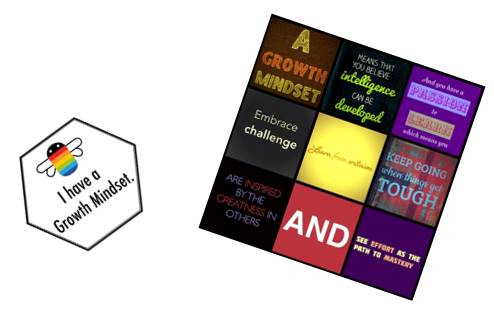Clare Hodgson, Assessment Adviser, looks at how schools can develop and embed a school-wide growth mindset culture, exploring the common mistakes made by schools when implementing and embedding a growth mindset culture and how these can be overcome.
Avoiding ‘wallpaper’ growth mindset: learning from other schools' mistakes
Carol Dweck’s seminal work on the Growth Mindset is now almost universally known. Many schools, recognising the relevance of the research to learner efficacy, have implemented the growth mindset approach – but with differing degrees of success. Embracing the notion that mistakes are learning opportunities, what can we learn about the issues and misconceptions that have arisen, as schools have endeavoured to embed the growth mindset school-wide? And most importantly, how can we pre-empt these errors, in order to build successful learning communities in our schools?
Central pitfall: ‘Wallpaper’ growth mindset

We all know this scenario. We attend a training session on the growth mindset. It resonates with us. Enthused and armed with resources and YouTube clips, we rush back to our classrooms and schools and plan a fantastic assembly or lesson introducing the growth mindset. We may put up some posters and info-graphics. However, somewhere along the way, we fail to ‘live and breathe’ the growth mindset operationally in school and in the classroom.
A by-product of this is that:
- Pupils and staff know they are ‘supposed’ to have a growth mindset and hide what they may be feeling.
- Pupils are told to make more effort, but not shown the steps it takes to succeed.
- Pupils may be shamed by staff and parents or berate themselves for not having a ‘growth mindset’ if they fail: it must be their fault for not persevering or putting in enough effort.
- While the growth mindset message is conveyed, the structures and systems in the school send conflicting messages to pupils (e.g. external reward culture, fairly static fixed ‘ability’ grouping, staff response to mistakes etc).
Overcoming this pitfall:
- There isn’t anything wrong with growth mindset posters and useful reminders on display. However, pay as much attention, if not more, to formative assessment and responsive feedback in the classroom to engineer success incrementally. Keep goals proximal and attainable rather than distant and insurmountable.
- Review school systems: do they align with your growth mindset vision? Are you, on the one hand, telling pupils that they can develop their intelligence and abilities, while on the other hand, reinforcing ideas of fixed intelligence through the structures and language in place in the school? Remove extrinsic rewards and static ability grouping. See here for how one school did this.
Pitfall #2: Praising Effort Alone
Carol Dweck’s work shows that praising students' process (their hard work, strategies, focus, and persistence) and tying it to their performance, learning, or progress can promote a growth mindset. But in many teachers' practice, it has become divorced from any learning or progress. "Great effort" becomes the consolation prize for pupils regardless of the outcome. So the very students who most need to learn a range of strategies, skills and knowledge to develop their abilities are instead receiving praise for their ineffective effort.
Overcoming pitfall #2:
Praise effort that is linked to progress. Do acknowledge laudable effort, but if that effort is not leading to enhanced achievement, then students need to be taught more effective learning strategies.
Assess the use of points or stars given for effort. For example, a system generated praise postcard based on effort scores (that may or may not be linked to achievement/attainment) doesn’t have the same impact as a subject teacher’s words to a pupil regarding effort coupled with achievement e.g. ‘You really listened to the feedback and now are writing like a scientist. You could go far in this subject’. Is there some further thinking around praise and rewards that may be of use in your school?
Pitfall #3: Failure to acknowledge or recognise the fixed mindset in each of us
It is a life-time’s journey to develop a growth mindset. As Dweck wrote: ‘We have come to realize that every one of us is a mixture of both mindsets: sometimes we're in a growth mindset, and sometimes we’re triggered into a fixed mindset by what we perceive as threats. These can be challenges, mistakes, failures, or criticisms that threaten our sense of our abilities -- for example, venturing into unknown territory with a new teaching method, confronting a student who is not learning, or comparing ourselves to a more accomplished educator. Are we inspired to try new things, or are we anxious or defensive?’
Overcoming pitfall #3:
Learn to listen and talk back to your ‘fixed mindset’ thoughts. Teach pupils to do the same through modelling your thought processes.
Pitfall #4: Celebrating mistakes, without reflection or meta-cognition
Rightfully, teachers have worked to make mistakes not only acceptable, but also desirable in the classroom. Mistakes should not be seen as an embarrassment, sign of failure or something to be avoided. They are signs of opportunities to learn and they are to be embraced. However, without close inspection and learning from these mistakes, simply celebrating their presence can lead to an acceptance of sloppy work or a repetition of the same mistake. It is the learning/change that we take away from the mistake that is key.
Overcoming pitfall #4:
Yes, make your classroom a safe environment to voice a misconception, or ask the ‘silly’ question, but also ensure that the mistake is explored and analysed to avoid the mistake being made again. Firstly, thank a pupil who may have made the mistake or given an incomplete answer, as if they did this, it is likely others in the class will too. Then, and this is key, don’t move away from the pupil by asking another pupil to supply the correct answer, but remain with that pupil allowing them to correct it themselves, or providing prompts and cues so that they can understand both their misconception, and how to correct it. Allow the pupil to rehearse voicing the correct answer. The message sent is that we all make mistakes, and each of us has the capability to learn from them.
Pitfall #5: Just add ‘yet’ to every negative statement

It is good to move pupil self-talk from the permanent and all-encompassing, to the movable and specific (as in the example above).
However, while it is good to add ‘yet’, it doesn’t go far enough if we don’t also show pupils how to improve incrementally and make progress.
Overcoming pitfall #5:
Do help pupils to re-frame their thinking, but also help them to move on. It is the feeling of getting ‘one more right than yesterday’ (improving) that will banish the feeling of hopelessness, not solely the addition of the word ‘yet’.
Pitfall #6: Reward systems, over-lavish praise and overly frequent grading
This is a ‘biggie’ and often the stumbling block. It relates to policies and systems, as well as how individual staff operate in their classroom. Sometimes we have been doing something one way for so long, it feels ‘inbuilt’ and immovable, at both these levels.
Research has repeatedly shown that teachers often use more superlatives/gold stars with low achievers and more critical feedback with high achievers. Indeed 69% of students prefer praise to be private and 17% prefer no praise, ‘probably because most praise is given to teacher-perceived low achievers and most criticism to high achievers,’ (Meyer, 2011). Low achievers often know that the teacher lavishes praises on them because they didn’t expect much of them. This re-enforces the message that there is a defect in them that they cannot do much about. High achievers often gain more rewards too (in the form of praise, high grades or points or stars). Yet this can lead to a build-up of pressure or else complacency. These pupils may not seek out challenges that show them up to be defective and simply seek marks rather than attend to the needs of their learning that these marks ought to reflect.
External rewards (including grades, stickers etc.) divert pupils' attention and energy away from their own learning, instead looking for ways to please the teacher/gain rewards. Alternatively, realising that they will never achieve high grade/rewards, many pupils (such as the ‘invisible middle’) ‘opt out’, stay under the radar, or ‘retire hurt’, therefore missing out on valuable learning. Moreover external rewards reinforce stereotypes and differences between learners that undermine the development of a safe, supportive and co-operative learning environment, where learners can enjoy high challenge, but low threat.
Overcoming pitfall #6:
Remove extrinsic reward systems. Avoid overpraising top and bottom end of the achieving scale. Give constructive feedback and advice across the attainment range.
Feedback to any pupil should be about the particular qualities of his or her work, with advice on what he or she can do to improve, and should avoid comparison with other pupils. For older children, adding this line:
“I am giving you this feedback because I believe in you”
(Cohen & Garcia, 2014)
to written feedback, has been proven to produce gains in learning, especially when also coupled with taking the time to give 5 to 10 minute 1 to 1 conference sessions across the year.
Grading should only take place after all the learning has taken place as, ‘grading carries the message that the work is over,’ (Hattie, 2018). Are you grading too frequently? Or grading as well as giving suggestions for improvements? If so, give the suggestions for improvements before the grading. Reflect on the journey. In this way, the pupil can make the improvements and reflect on the efficacy of the process to get to the grade. If successful, what led to the success? If really necessary (towards the end of the year), grade, but don’t give a comment: you would be wasting your time. (See p13-14 Working Inside the black box: Assessment for Learning in the Classroom by Paul Black, Christine Harrison, Clare Lee, Bethan Marshall, and Dylan Wiliam for more advice on feedback that works.)

In conclusion, remember that the growth mindset is the belief that qualities can change and that we can develop our intelligence and abilities. So let’s take the growth mindset from ‘wallpaper’ into the very foundations of your school and into the classroom itself. If I were to sit in your classroom, would I feel, hear and see the growth mindset in action?
Further reading and links
Mindset; how you can fulfil your potential, Carol Dweck
Outstanding Formative Assessment: Culture and Practice, Shirley Clarke
Visible Learning: Feedback, John Hattie and Shirley Clarke
Punished by Rewards, Alfie Kohn
The Expert Learner: challenging the myth of ability, Gordon Stobart
Working Inside the black box: Assessment for Learning in the Classroom, Paul Black, Christine Harrison, Clare Lee, Bethan Marshall, and Dylan Wiliam
Carol Dweck Explains The 'False' Growth Mindset That Worries Her
Tom Sherrington Engineering Success. A positive alternative to generic mindset messaging
Shirley Clarke Learning Teams
Jo Boaler When you believe in your students, they do better
Jo Boaler Ability Grouping
Youcubed: Rethinking giftedness
Interested in more training on assessment and the growth mindset?
Contact the Assessment team at hfl.assessment@hfleducation.org for enquiries about bespoke training packages or other courses.



